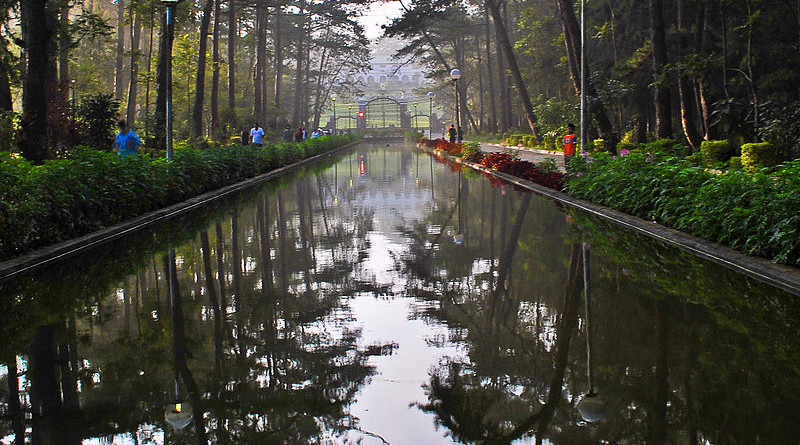Philippines’ City Of Pines Need Moratorium To Save Trees – OpEd
They say when economy is put over ecology, it is greed. This is what happened to the Philippines’ most famous tourist city, a victim of overexploitation, commercialism and environmental neglect.
I was invited as key speaker by Congressman Mark Go, lead convenor, to the First Land Use Congress of Baguio City known as the Philippines’ “Summer Capital and City of Pine Trees” because it was once a place with millions of Pinus insularis pine trees, which gave the city a cool climate year-round.
The Congress aimed to come out with solutions that will stop environmental degradation. Baguio, today, is faced with worsening urban sprawl where much of its delicate environment has suffered in the name of economic progress leading Pres. Rodrigo Duterte to let it undergo “redevelopment” to allow unborn generations enjoy the city’s beautiful environment and cool weather.
Over the past years, the city of Baguio has grown in terms of population, number and different business establishments, residential areas and other economic activities. But these came different and alarming urban sprawl negative consequences.
As a result of poor comprehensive urban planning wanting of vision and foresight, landscapes have been destroyed, thousands of pine trees cut, particularly in Camp John Hay, wild but beautiful plants pushed to extinction (eg. Lady’s slipper), sources of water destroyed, garbage increased, and air poisoned and polluted in the city’s 67 sq. km area.
Tree Cutting Moratorium
In my message, I advocated for a 20-year tree cutting moratorium and a halt of any large commercial infrastructure in government and private lands. It is the only way to save the remaining trees and the landscape.
I explained that pine trees lower temperature. When Baguio had more pine trees, the city was cooler; it deserved to be called the “City of Pines”. Today, the city is not only warm, congested and dirty but also dubbed by World Bank as having one of the cities in the world with the “dirtiest air” as thousands of trees were allowed by the city government to be cut to give way to commercial and residential buildings, roads, tourism and hotels.
Clumps of pine trees and all trees for that matter reduce mid-day temperature from a minimum of 0.2 degrees C to 1.3 degrees C some 1.5 meters to 2.4 meters above ground,I elaborated.
Below individual and small fragments of pine trees over grass, mid-day air temperatures can be reduced to as low as 0.7C to 1.3C degrees cooler than in any open area.
When pine trees respire, they emit oxygen which do not only reduce air temperature, but also absorb radiation and store heat. They also reduce relative humidity, turbulence, and surface albedo of concrete. These changes in local meteorology alter pollution concentrations in urban areas.
Trees’ Importance
The city’s pine trees remove air pollutants. Even though pine trees leaves are needle-type, they function as normally as a broadleaf. The needles through their stomata, remove deadly gaseous air pollution primarily by uptake.
I added once inside the leaf, gases diffuse into intercellular spaces and may be absorbed by water films to form acids or react with inner-leaf surfaces. The trees also remove pollution by intercepting airborne particles. Most particles like CO2 are absorbed into the tree, and eventually stored in the soil by the roots.
Some particles that are intercepted are retained on the plant surface. These are resuspended to the atmosphere, washed off by rain, or dropped to the ground with leaf and twig falls. Consequently, vegetation is only a temporary retention site for many atmospheric particles.
The city’s pine trees reduce Urban Island Phenomenon and temperature on buildings. Urban Island phenomenon is the heat transferred from cities via highway and roads to outlying communities. Pine tree reduce this, as well as lessen building energy use by lowering temperatures and shading buildings during the summer, and blocking winds during rainy season.
When building energy use is lowered, pollutant emissions from power plants are also lowered. The cumulative and interactive effects of trees on meteorology, pollution removal, and power plant emissions determine the overall impact of trees on air pollution.
It is God’s design that trees give us oxygen, absorb GHG, give us water, cleanse the air, prevent erosion, give us shade, and and give us unlimited benefits. But we are defiling God’s design. We are only concerned on exploiting them. Trees mean life. They and all creation must be treated as sacred, I emphasized.
No Tree Cutting Permits
I also called on the government’s Department of Environment and Natural Resources or DENR and the Baguio city government to stop issuing tree cutting permits.
I stressed on the strict implementation of the national law Republic Act 3571, which prohibits the cutting, destroying or injuring of planted and growing trees in any public sites, parks, schools, roads, and plazas.
If the government does not act now. It will not also lose a city that boasted of more than a century of unique natural beauty, envied by millions of tourists, but also a center of educational excellence and cultural paradox.


If you really want to save the remaining green patches, then don’t just target those lands being acquired by corporations and businesses. A bigger contributor to what Baguio has become is the sale of old residential lands where trees used to stand. What this new generation of land buyers don’t really appreciate is the fact that old-timers used to preserve the green spaces even in their own backyards. Go ahead and check Facebook and see that almost all of the new residential lots that are being sold have trees and they eventually become concrete houses without gardens. These are eating up Baguio’s remaining green spaces.